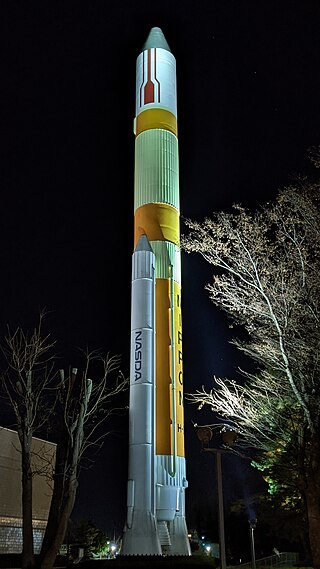Top Qs
Timeline
Chat
Perspective
H-II
Japanese rocket From Wikipedia, the free encyclopedia
Remove ads
The H-II (H2) rocket was a Japanese satellite launch system, which flew seven times between 1994 and 1999, with five successes. It was developed by NASDA in order to give Japan a capability to launch larger satellites in the 1990s.[1] It was the first two-stage liquid-fuelled rocket Japan made using only technologies developed domestically.[2] It was superseded by the H-IIA rocket following reliability and cost issues.
Remove ads
Background
Summarize
Perspective
Prior to H-II, NASDA had to use components licensed by the United States in its rockets. In particular, crucial technologies of H-I and its predecessors were from the Delta rockets (the manufacturer of the Delta rockets, McDonnell Douglas, later Boeing and the United Launch Alliance, would later use the H-IIA's technologies (the rocket itself is the successor to the H-II) to create the Delta III, albeit short lived). Although the H-I did have some domestically produced components, such as LE-5 engine on the second stage and inertial guidance system, the most crucial part, the first stage engine, was a licence-built version of the Thor-ELT of the US. By developing the LE-7 liquid-fuel engine and the solid booster rockets for the first stage, all stages of H-II had become "domestically developed".
The H-II was developed under the following policies, according to a NASDA press release:[1]
- Develop the launch vehicle with Japanese space technology.
- Reduce both development period and costs by utilizing developed technologies as much as possible.
- Develop a vehicle which can be launched from the existing Tanegashima Space Center.
- Use design criteria which allows sufficient performance for both the main systems and subsystems. Ensure that development will be carried out properly, and safety is taken into account.
The H-II was new, incorporating larger LH2/LOX tanks, and a new upper stage, consisting of a cylindrical LH2 tank with a capsule-shaped LOX tank. The LH2 tank cylinder carried payload launch loads, while the LOX tank and engine were suspended below within the rocket's inter-stage. The second stage was powered by a single LE-5A engine.[3]
Remove ads
History
Summarize
Perspective
Development of the LE-7 engine which started in 1984 was not without hardships, and a worker died in an accidental explosion. The first engine was completed in 1994, two years behind the original schedule. The Rocket Systems Corporation (RSC), a consortium of 74 companies including Mitsubishi Heavy Industries, Nissan Motors, and NEC, was established in 1990 to manage launch operations after the rockets' completion. In 1992, it had 33 employees.[4]
In 1994, NASDA succeeded in launching the first H-II rocket, and succeeded in five launches by 1997. However, each launch cost 19 billion yen (US$190 million), too expensive compared to international competitors like Ariane. (This is in part due to the Plaza Accord's changes to the exchange rate, which was 240 yen to a dollar when the project planning started in 1982, but had changed to 100 yen a dollar by 1994.) Development of the next-generation H-IIA rockets started in order to minimize launch costs.
In 1996, RSC signed a contract with the Hughes Space and Communications Group to launch 10 satellites. The successive failure of flight 5 in 1998 and flight 8 in the following year brought an end to the H-II series and the contract with Hughes.[5] To investigate the cause of the failure and to direct resources into the H-IIA, NASDA cancelled flight 7 (which was to be launched after F8 due to changes in schedule), and terminated the H-II series.[2]
Remove ads
Launch history
Gallery
- The Ground Test Vehicle of H-II, now installed at Tsukuba Space Center.
- The first and second stages of the canceled Flight 7, at a hangar in Tanegashima Space Center.
See also
References
External links
Wikiwand - on
Seamless Wikipedia browsing. On steroids.
Remove ads



